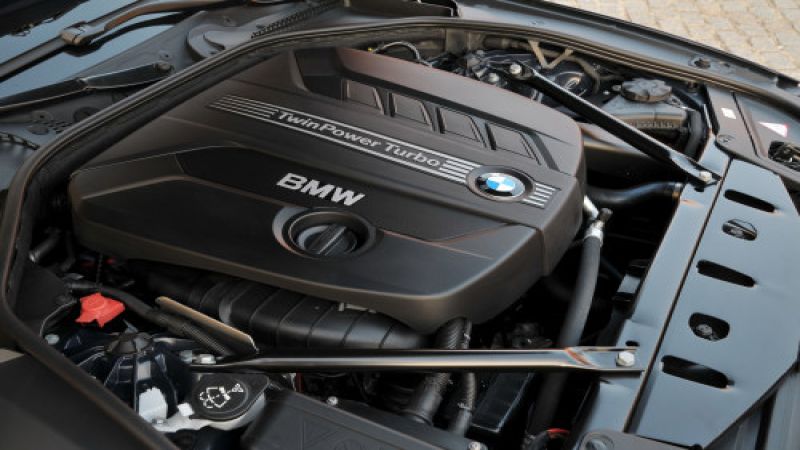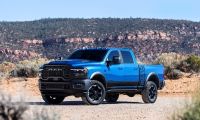Think further on highly efficient engines from BMW, more standard-fitted BMW EfficientDynamics measures and attractive additions will be made to the optional equipment range, reaffirming the BMW 5 Series’ benchmark position on efficiency and driving enjoyment at the premium end of the upper mid-range segment.
According to the BMW Group press release, BMW TwinPower Turbo technology is key to maintaining this benchmark position. In fact, more diesel engines will get this technology too.
Also among the autumn lineup, the BMW 5 Series Touring line-up will be joined by a new top-of-the-line model, the BMW 550i Touring with V8 engine. All these measure will help the BMW 5 Series extend its segment leadership as the model range with the best balance of driving enjoyment and fuel economy.
The most fuel-efficient model of all is the BMW 520d EfficientDynamics Edition, which achieves average fuel consumption in the EU test cycle of 4.5 liters per 100 km (62.7 mpg imp) and CO2 emissions of 119 grams per kilometer.
BMW TwinPower Turbo technology
With the launch of a new generation of four-cylinder engines with BMW TwinPower Turbo technology, the BMW 5 Series engines for the upper mid-range market now lead the way on efficiency and sporty power delivery in the petrol segment too.
If this sounds a bit familiar, you are right. For the record, Ford’s EcoBoost has been using twin turbos with downsized engines to achieve better emissions along with higher levels of power density. Notice how nobody, including Ford and BMW, have yet to introduce split-cycle versions of their engines; preferring to buy time by engine downsizing and powering up with turbos.
Nonetheless, BMW views its technology as world-exclusive technology that equips the two 2.0-litre engines with twin-scroll turbocharging, High Precision Injection direct injection, VALVETRONIC variable valve timing and Double-Vanos variable camshaft timing. This combination of features is inspired by the technology package used on the multi-award-winning 225 kW/306 hp six-cylinder in-line BMW TwinPower Turbo engine of the BMW 535i.
According to BMW news release documents, BMW has adopted this highly efficient, performance-boosting technology in the four-cylinder engines as well. The system, which delivers the exhaust gases from each pair of cylinders to the turbine via two separate channels, both in the exhaust manifold and in the turbocharger itself, provides more responsive performance. The fuel supply is precisely metered by the direct-injection system with solenoid injectors, while the latest version of the VALVETRONIC system provides even more precise air mass control and, in combination with Double-Vanos variable intake and exhaust camshaft timing, optimizes both efficiency and response.
The following details were availed in a news PDF document: As fitted in the new BMW 520i, the four-cylinder engine develops maximum power of 135 kW/184 hp at 5, 000 rpm and peak torque of 270 Newton metres (199 lb-ft), which is available between 1,250 and 4,500 rpm. Instantaneous power response helps the BMW 520i Sedan perform the 0 to 100 km/h (62 mph) sprint in 7.9 seconds (automatic: 8.0 seconds), while the BMW 520i Touring accomplishes the same task in 8.3 seconds (automatic: 8.4 seconds). Top speeds are 227 km/h (141 mph) (automatic: 226 km/h / 140.4 mph) for the Sedan and 220 km/h (36.7 mph) (manual and automatic) for the Touring model. Simultaneous efficiency improvements are reflected in average fuel consumption (as per EU test cycle, depending on tyre format) of 6.8 – 7.0 l/100 km (40.3 – 41.5 mpg imp) (automatic: 6.5 – 6.7 litres / 42.2 – 43.5 mpg imp) and CO2 emissions of 157 – 163 grams (149 – 155 grams) per kilometre. For the BMW 520i Touring, the corresponding figures are 7.0 – 7.3 l/100 km (38.7 – 42.2 mpg imp) (automatic: 6.7 – 7.0 litres / 40.3 – 42.2 mpg imp) and 163 – 170 grams (automatic: 156 – 163 grams) per kilometre.
In the new BMW 528i, with modified turbocharging and injection technology, the four-cylinder engine develops maximum power of 180 kW/245 hp at 5,000 through 6,500 rpm, and peak torque of 350 Newton metres (258 lb-ft), which is available between 1,250 and 4,800 rpm. 0 to 100 km/h (62 mph) is accomplished in 6.2 seconds for the new BMW 528i Sedan (automatic: 6.3 seconds), and 6.4 seconds for the BMW 528i Touring (automatic: 6.6 seconds). Top speeds are 250 km/h (155 mph) for the Sedan and 244 km/h (151.6 mph) for the Touring model (in both cases the figures are the same for both manual and automatic versions). The new BMW 528i Sedan achieves average fuel consumption (as per EU test cycle, depending on tyre format) of 6.8 – 7.1 l/100 km (39.8 – 41.5 mpg imp) (automatic: 6.5 – 6.8 litres / 41.5 – 43.5 mpg imp), and CO2 emissions of 159 – 165 grams (automatic: 152 – 158 grams) per kilometre. For the new BMW 528i Touring, the corresponding figures are 7.1 – 7.4 l/100 km (38.3 – 39.8 mpg imp) (automatic: 6.8 – 7.1 litres / 39.8 – 41.5 mpg imp) and 165 – 172 grams (automatic: 159 – 166 grams) per kilometre.
New diesel engines for the BMW 5 Series
Expect more power and efficiency for diesels as well, courtesy of BMW TwinPower Turbo technology.
For the other diesel engines in the BMW 5 Series, autumn 2011 will bring further improvements in power, and further reductions in fuel consumption, in line with the twofold goal of BMW EfficientDynamics.
The BMW 525d, for example, will get a new four-cylinder diesel engine with BMW TwinPower Turbo technology. This 2.0-litre all-aluminium unit features Variable Twin Turbo two-stage turbocharging and common-rail diesel injection with piezoelectric injectors. The new unit features reduced weight and, thanks to the VNT technology of the small turbocharger, instantaneous response. The small turbocharger comes on stream at low engine speeds, while the contribution from the larger turbocharger varies in precise response to throttle requirements.
-----------------------
About the Reporter: After 39 years in the auto industry as a design engineer, Frank Sherosky now trades stocks, futures and writes articles, books and ebooks like, "Perfecting Corporate Character," "Awaken Your Speculator Mind", and "Millennial World Order" via authorfrank.com. He may be contacted here by email: [email protected] and followed in Twitter under @Authorfranks
________________________________________________
Additional Reading:
Tour Engine split-cycle technology draws interest at 2011 DEER Conference in Detroit
Tech synergies permeating IC engine development per 2011 DEER Conference
Navistar reports Super Truck accomplishments at 2011 DEER Conference
Evening 10/03 Update: 2011 DEER Conference at Detroit
Tour Split-Cycle Engine technology display
Altair unveils world's first hydraulic-hybrid transit bus
Scuderi Split-Cycle Engine achieves 65 MPG under simulation study
Achates Power addresses commercial truck mileage and emission standards
Raytheon: Cyclone Power's combustion engine game changer











